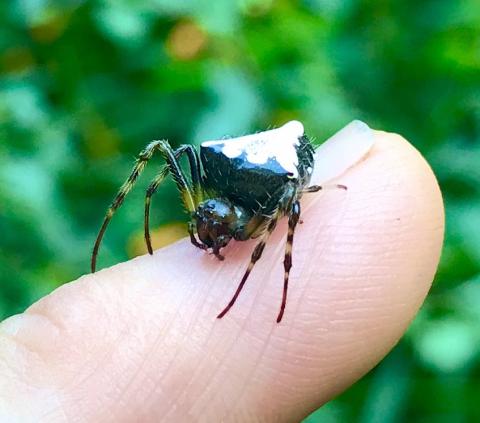A face full of spiderweb
By Steve Roark
Volunteer Interpreter, Cumberland Gap National Historical Park
If you hike in the woods late summer into fall you are likely to have a face to literal face run-in with spiderweb.
The culprit is the spiny orb weaver, who has a knack for building webs across trails at eye level. The number of webs increase this time of year as the spiders increase their food energy intake to be able to lay eggs before hard winter sets in.
The name of this spider sums up how to identify it. The spiny orb is all black except for its hard, spiny abdomen, which you’ll feel when you wipe one off your nose after a run-in.
There are six thorny spines on the abdomen, though there is a lot of variation in the species, and the ones I mostly see have spines that aren’t showy, but they’re there.
There is usually some coloration on the top of the abdomen, and the more common ones around here are mostly white and sometimes yellow. Orb refers to the design of spider web, which is the familiar round, flat web with a spiral series of spokes, which most folks think of when it comes to spiders.
If you’ve read the book Charlette’s Web, she made orb webs, but was a spotted orb-weaver, also call a barn orb-weaver. But there are other web types made by other spider species, such as the funnel web, sheet web, and tangle web (cobweb).
The purpose of the web of course is food acquisition, predominately flying insects, which makes the spiny orb a valued member of the forest, which is where it prefers to construct its trap.
They eat a lot of mosquitos, so hats off to them. Web building occupies a lot of their time because they build a new one each day. Only the female builds the big fancy webs we run into, and she makes a disk in the center where she sits and waits for lunch.
When the web makes a capture, she will go to it, immobilize the victim with some venom. The venom gradually liquifies the insides of the prey, which is consumed vampire-like, and the carcass is discarded.
The male spiny orb is much smaller than the female, a phenomenon referred to as sexual dimorphism. Males build smaller webs close to a female’s and waits for what he thinks is an opportune time to woo her to mate.
He does so by tentatively visiting her web and uses a four-tap rhythmical pattern, drumming on the silk to get her attention. If all goes well, he will approach her and if contact is made, they mate. After mating the male remains on the web and is eventually eaten by the female.
The female will eventually lay around a hundred eggs and place them in an egg sac which is a loose, spongy, tangled mass of threads. The mother will guard the egg sac at first but will eventually attach it to the underside of vegetation where the eggs will overwinter and hatch in the spring.
The spiny orb makes a web that is an absolute work of art, best appreciated when it has an early morning coating of dew. That and their benefit of reducing bug populations makes it worth forgiving them when you have a too-close encounter with them.
- Log in to post comments
